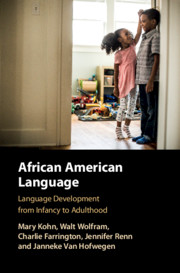Book contents
- African American Language
- African American Language
- Copyright page
- Contents
- Figures
- Tables
- Preface
- Abbreviations
- 1 Coming of Age in African American Language
- 2 The Analysis of Sociolinguistic Change over the Lifespan
- 3 Profiles of Change
- 4 Vowel Variation across Time and Space
- 5 Caretaker’s Influence on Vernacularity
- 6 The Influence of Peers on the Use of African American Language
- 7 Stylistic Variation in the Early AAL Lifespan
- 8 The Relationship of African American Language and Early Literacy Skills
- 9 A Longitudinal Study in Retrospect
- Appendix AAL Feature Code Key
- Index
- References
8 - The Relationship of African American Language and Early Literacy Skills
Published online by Cambridge University Press: 24 November 2020
- African American Language
- African American Language
- Copyright page
- Contents
- Figures
- Tables
- Preface
- Abbreviations
- 1 Coming of Age in African American Language
- 2 The Analysis of Sociolinguistic Change over the Lifespan
- 3 Profiles of Change
- 4 Vowel Variation across Time and Space
- 5 Caretaker’s Influence on Vernacularity
- 6 The Influence of Peers on the Use of African American Language
- 7 Stylistic Variation in the Early AAL Lifespan
- 8 The Relationship of African American Language and Early Literacy Skills
- 9 A Longitudinal Study in Retrospect
- Appendix AAL Feature Code Key
- Index
- References
Summary
This chapter examines the relationship between the use of African American Language (AAL) and the third grade outcomes of the development of reading skills and academic success assessments. Third grade is of particular importance because it is the point when standardized testing takes place for the first time and many future achievement patterns are set. Children’s reading skills were measured by standard scores on the different components of the Woodcock & Johnson test in third grade, including the Letter-Word ID task testing the child’s knowledge of letters and words, the Passage Comprehension items assessing reading comprehension, and the Word Attack Skills section evaluating the child’s phoneme/grapheme knowledge. The analysis suggests that more regular observed use of AAL in early elementary school is related to the development of Mainstream American English language and literacy skills above and beyond the effects previously attributed to home and school factors. The results further found that AAL use was significantly related to lower scores on Letter-Word ID test, but not on the other two reading tests. The regression results imply that when a child encounters different language varieties at home and in the classroom, it may make it more difficult for young learners to develop decoding and vocabulary skills.
Keywords
- Type
- Chapter
- Information
- African American LanguageLanguage development from Infancy to Adulthood, pp. 191 - 207Publisher: Cambridge University PressPrint publication year: 2020

